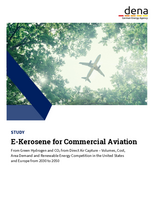
Berlin, September 8, 2022. 99.9 percent of fuel in commercial aviation is fossil kerosene. Since batteries are too heavy and hydrogen fuel cells are not powerful enough, aviation predominantly focusses on climate-neutral liquid fuels, namely bio-kerosene and e-kerosene to decarbonise. A study by dena, developed in collaboration with LUT and LBST, shows for the first time how much e-kerosene will be needed in Europe, the U.S. and world-wide for the aviation sector to be completely independent of fossil fuels in 2050. Through a quantitative scenario analysis, the use of fossil-free jet fuels was compared with e-kerosene produced with CO2 from DAC (DAC kero-sene). This included quantifying production costs and the land area requirements in order to finally derive actionable policy recommendations.
The study concludes that due to the limited availability of bio-kerosene and other technological alternatives, nearly 60 percent of fuel demand will need to be met by e-kerosene in 2050. The biggest challenge is that the production of e-kerosene requires significant amounts of CO2: Over 90 percent of the CO2 required for e-kerosene production in 2050 will need to be met by DAC. This translates to extracting 161 to 281 million tons of CO2 per year from air via DAC in Europe, and 102 to 176 million tons of CO2 per year in the United States.
Andreas Kuhlmann, Chairman of dena's Executive Board: "Such analyses are important for putting concrete figures on the energy transition. Direct Air Capture has an important role to play in fossil-free aviation. But the challenge is enormous. Are Europe and the U.S. ready to dedicate so much renewable power to fossil-free aviation? Or should we consider other, non-technological solutions, such as capping demand? We need to find the right balance between what is economically feasible and socially acceptable."
Matteo Micheli, senior expert on hydrogen and synthetic fuels and lead author for dena: "The industry is already building a significant e-kerosene market. In Europe, e-kerosene projects with final investment decisions are expected to produce at least 1.83 million tons of e-kerosene in 2030. An important finding from our work is that we need to develop DAC plants in addition to e-kerosene plants to supply e-kerosene production with sustainable CO2. And we need to start today."
To produce the required amount of DAC kerosene domestically in 2050, the U.S. would need to generate up to 1,250 TWh/year of renewable electricity for DAC kerosene production alone. Europe, as much as 2,000 TWh/year. By comparison, Europe produced about 1,700 TWh/year of renewable electricity for all end uses in 2021. This means that by 2050, it would need to generate more than all of today's renewable electricity, for e-kerosene production alone. The same is true for the U.S., which generated 860 TWh of electricity from renewables (excluding nuclear) in 2021.
Still, DAC kerosene has strong advantages: It requires 70 times less area than bio-based alternatives and no agricultural land at all, and it can be used in today's aircraft without modifications. DAC kerosene is a technically scalable solution that is resource intensive. As such, it is not the only solution for fossil-free aviation, but it is a crucial one which needs increased attention starting today.
Picture: shutterstock/Sergey Tinyakov
